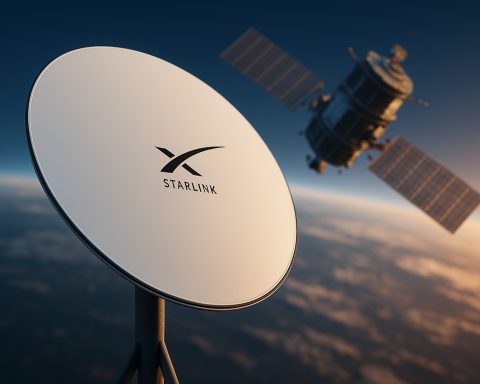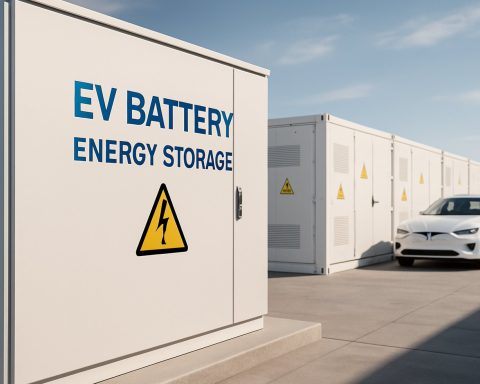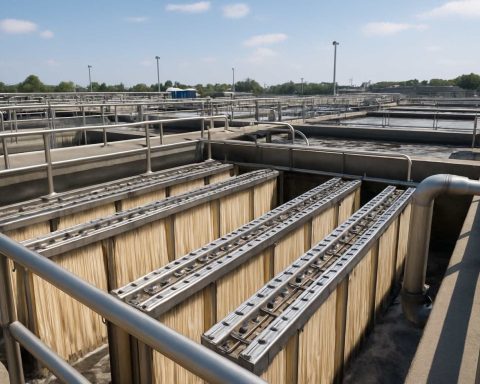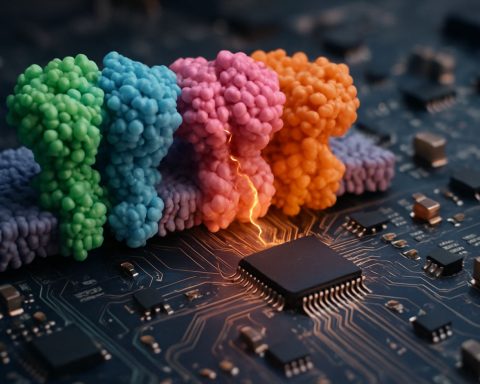- Fluoride-ion batteries could double electric vehicle energy density and range, reaching up to 745 miles per charge.
- Developed by Kyoto University and Toyota, these batteries feature a novel copper nitride cathode.
- Battery efficiency thrives on the interaction of copper nitride, manganese, and lanthanum in a perovskite crystal structure.
- The batteries offer a volumetric capacity three times that of current lithium-ion counterparts.
- Fluoride-ion technology’s longevity allows for numerous recharge cycles without capacity loss.
- The technology promises broader applications across various energy sectors, enhancing renewable energy storage.
- A high reversible capacity of 550 mAh/g sets a new benchmark for battery chemistry.
- Ongoing research includes refining the anode and solid electrolyte for full battery system optimization.
- Collaboration between innovators like Toyota and researchers is key to overcoming technical challenges.
- The potential of fluoride-ion batteries extends beyond vehicles, influencing global energy systems.
A bold frontier in battery technology is emerging, one that promises to double the energy density of electric vehicles and extend their range beyond imagination. This breakthrough comes courtesy of pioneering research into fluoride-ion batteries, developed in collaboration with Toyota and spearheaded by a dedicated team at Kyoto University. At the heart of this innovation lies a novel cathode material constructed from copper nitride, reshaping the future of energy storage.
Imagine a world where electric vehicles glide effortlessly over 745 miles on a single charge, nearly twice the reach of today’s lithium-ion powered alternatives. The secret lies within the interplay of copper nitride, manganese, and lanthanum, forming a complex dance of elements within a perovskite crystal structure. This configuration allows fluoride ions to zigzag through the solid electrolyte, conducting energy with unparalleled efficiency and safety.
The science is as electrifying as the batteries themselves. Copper nitride enables a groundbreaking reaction with nitrogen and fluoride ions, unlocking a robust three-electron delivery per nitrogen atom. The benefits are twofold: a volumetric capacity thrice that of lithium-ion rivals and a resilient longevity that can endure countess recharge cycles without faltering.
But the conquest doesn’t stop at electric vehicles. The allure of fluoride-ion batteries extends into broader energy sectors, offering a glimpse into a future where energy storage surpasses current limitations. The cathode’s reversible capacity, an impressive 550 mAh/g, heralds a new era of battery design, showcasing how innovative chemistry can meet the demands of a world increasingly reliant on renewable energy solutions.
However, crafting a comprehensive all-solid-state fluoride-ion battery system requires more than just an advanced cathode. The research journey involves perfecting complementary elements like the anode and solid electrolyte. These components are critical to unlocking the full potential of this revolutionary battery technology.
In the relentless pursuit of energy excellence, researchers are refining each piece of the puzzle, driven by teamwork and shared aspirations. Reports indicate that overcoming these technical challenges is just a matter of time and collaboration, as industry leaders like Toyota join forces with scientific minds. Together, they aim to usher in an era where energy storage devices redefine our capabilities and reshape industries.
The future brims with possibilities as fluoride-ion batteries set a new standard for what modern energy systems can achieve. It’s not just about extending the range of electric vehicles—it’s about redefining our relationship with energy, with implications that could ripple across sectors and enrich our daily lives. As we stand on the cusp of this technological revolution, the question remains: How will this newfound energy wisdom transform our world?
Revolutionizing Energy: How Fluoride-Ion Batteries Could Transform the Future
Fluoride-Ion Batteries: The Next Leap in Energy Storage
Fluoride-ion batteries (FIBs) are emerging as a revolutionary force in the world of energy storage, particularly in enhancing the range and efficiency of electric vehicles (EVs). Spearheaded by groundbreaking research from Kyoto University in collaboration with industry giant Toyota, these batteries signal a potential shift away from the conventional lithium-ion technology that currently dominates the market.
How do Fluoride-Ion Batteries Work?
The core innovation in FIBs lies in the use of a copper nitride cathode, coupled with manganese and lanthanum. This configuration is structured into a perovskite crystal lattice, allowing fluoride ions to efficiently conduct electricity through a solid electrolyte. A crucial advantage of this setup is its ability to deliver a robust three-electron reaction per nitrogen atom, significantly enhancing energy density and longevity.
Advantages Over Lithium-Ion Batteries
1. Increased Energy Density: The volumetric capacity of FIBs is three times greater than that of traditional lithium-ion batteries, paving the way for EVs that can travel up to 745 miles on a single charge.
2. Durability and Longevity: FIBs promise an extended lifespan, enduring countless recharge cycles without significant performance degradation.
3. Safety and Efficiency: The use of solid-state components mitigates risks associated with liquid electrolytes, such as leakage and flammability.
Broader Implications in Energy Storage
Beyond electric vehicles, FIBs hold potential across various sectors, especially in renewable energy storage. Their impressive reversible capacity of 550 mAh/g makes them suitable for applications that require high energy retention and reliability over extended periods.
Overcoming Technical Challenges
Developing a comprehensive all-solid-state fluoride-ion battery system involves more than just a breakthrough cathode. Researchers are tackling the challenges of designing complementary components like the anode and solid electrolyte to maximize the potential of this technology. Success in these areas will likely hinge on continued industry collaboration and innovation.
Market Potential and Future Trends
According to market forecasts, the demand for advanced battery technologies is set to surge as industries seek sustainable and efficient energy solutions. With leaders like Toyota heavily investing in FIB technology, the coming decade could see significant shifts in both consumer electronics and large-scale energy storage systems.
Real-World Applications
– Electric Vehicles: With enhanced range and efficiency, FIBs could make EVs more viable for long-distance travel without frequent recharging.
– Renewable Energy: Providing stable and efficient energy storage, FIBs can support solar and wind power installations, ensuring energy availability even during periods of low generation.
– Portable Electronics: The longer life and higher capacity of FIBs can transform the landscape of consumer electronics, allowing for gadgets with prolonged usage times.
Potential Limitations and Challenges
While promising, the full-scale adoption of FIBs faces hurdles, including:
– Material Challenges: Procuring and processing the specific materials needed for FIB construction can be costly and complex.
– Commercial Viability: Bridging the gap from laboratory innovation to commercial-scale production requires significant investment and refinement.
Actionable Tips for Consumers
– Stay Informed: Keep an eye on emerging technologies in the energy sector, especially if you’re considering an electric vehicle purchase in the near future.
– Evaluate Your Energy Needs: Whether for personal or commercial use, assess how advances in battery technology could benefit your energy consumption patterns.
For more information on energy innovations, explore the latest from Toyota and stay updated on Kyoto University’s research efforts.
As industries worldwide pivot towards sustainability, the potential of fluoride-ion batteries represents a beacon of hope in achieving unprecedented milestones in energy efficiency. The future is on the horizon, and it’s powerfully charged.











